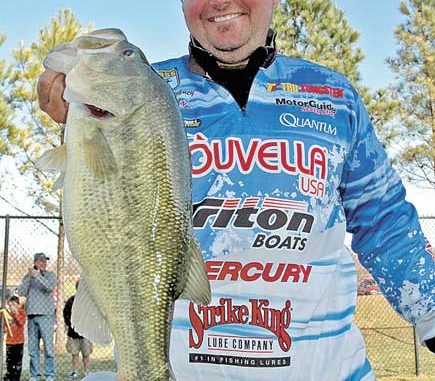
This time of year, floating saltwater baits rather than retrieving them offers practical and strategic benefits.
I finished in 20th place on the Red River in the 2009 Bassmaster Classic. I completely misread what the bass were doing. Since I assumed the male bass were preparing the nests, and the females hadn’t come in to spawn yet, my game plan was to fish the deeper water where I thought the bigger female bass were holding and not fish the shallow water.
I spent most of my time fishing 3 to 6 feet of water, but most of the bass already had moved into the shallow water to spawn.
This tournament was one of the few I could look back on and say I fished in water too deep. I didn’t realize the females already had left their staging areas and moved shallow during the Classic.
Most of the top-10 finishers were fishing the spawning flats and catching those big females that already had moved in to spawn. On the final day of the Classic, I changed tactics, fished isolated cover where I thought the big fish might be and caught the biggest bass — 7 pounds, 1 ounce — of any pro on the last day. But the Classic ended before I found many big bass, although I gave it my best shot.
Lake Providence
The Classic is history, so let’s talk about bass fishing in April. I’ll fish on Lake Providence in the northeast corner of the state.
Numbers of male fish will be in the shallow water guarding fry at Lake Providence during April. The shallow-water bite will be great at the first of April. In the middle of the month, the shad will start spawning in Lake Providence’s shallow water. Then all the big female bass that have moved out after the spawn will return to the shallow water to feed on those shad spawning around boat docks, piers, seawalls, cypress trees and shallow-water cover.
The first of April — the Spit-N-King
This month I’ll start my morning fishing with a topwater popper like the Spit-N-King, and that lure will be the most productive at the first of April when the male bass are in that shallow water guarding the fry. On some days, particularly during the first two weeks of the month, I’ll fish the Spit-N-King all day, and use a pop, let-it-sit, pop, let-it-sit type of action to imitate a bass, a bluegill or a crappie that’s eating young bass fry.
When those male bass see what they believe to be a predator fish feeding on the bass fry, they’ll become really aggressive and attack the Spit-N-King, even if they’re not trying to eat the lure. I’ll automatically get a strike just about any time I work a chugger bait through fry by using a steady popping retrieve — not too fast or too slow.
Mid-April — the Shad Spawn
In the middle of April, the shad will start spawning on Lake Providence. That’s when I’ll start fishing spinnerbaits, like a 3/8-ounce double willowleaf Strike King Premier Elite, either in green shad or chartreuse/white, early in the morning. You can cast a spinnerbait, start reeling it in and actually feel the shad hitting the lure. Bass seem to have a homing device that helps them locate the shad, once the shad start spawning.
Early in the morning when the shad start spawning, a large congregation of all types of fish — bass, crappie, catfish and bluegills — will be around those spawning shad. Those first two hours of the morning, you’ll catch a bunch of bass fishing a spinnerbait through those spawning shad.
As that early morning bite ends, I’ll start using the new Hack Attack Jig made by Strike King to catch the bass in either a 3/8- or 1/2-ounce jig. In dirty water, I’ll fish the black/blue or Texas craw colors. But if the water’s clear, I’ll probably use a pumpkin/green/bluegill or the bull-bream color jig. I’ll spend the rest of the day flipping cypress trees and boat docks with that jig because I want to catch big bass.
Lake Providence has numbers of bass in the 3- to 6-pound range. When I’m flipping the jig, I’m not fishing for a lot of bites but rather those really nice bass, and I enjoy fishing isolated boat docks and cypress trees or on cypress points. After the spawn, often those bigger females prefer to take up residence on isolated cover where they can be by themselves. Of course, some of the big bass will group together. Most of those better bites will come in 3 to 5 feet of water, depending on the water color.
If this section of Louisiana receives a lot of rain in April, that dirty water will move the bass closer to the surface and to the shore. Then I’ll flip a jig on 50-pound-test Cajun braid with a 7-foot 11-inch Quantum Greg Hackney Flipping Stick.
Providence is a great lake to fish this month where I can regain my confidence after the Bassmaster Classic on the Red River the end of February.


